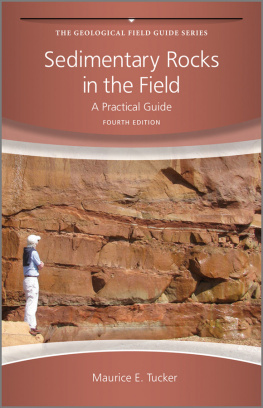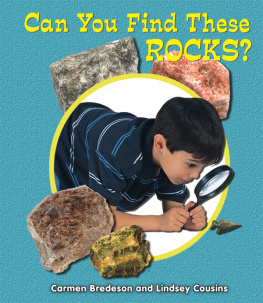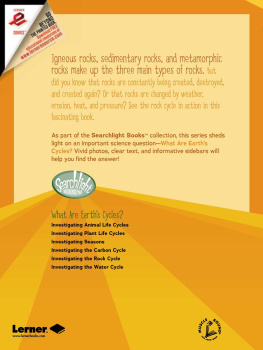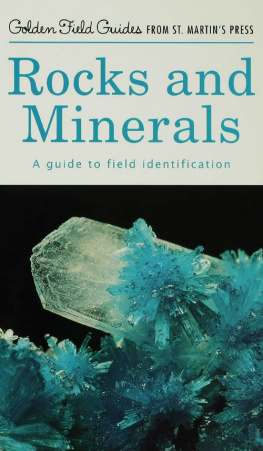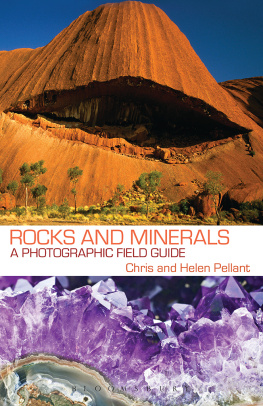Tucker - Sedimentary rocks in the field: a practical guide
Here you can read online Tucker - Sedimentary rocks in the field: a practical guide full text of the book (entire story) in english for free. Download pdf and epub, get meaning, cover and reviews about this ebook. year: 2011, publisher: Wiley, genre: Children. Description of the work, (preface) as well as reviews are available. Best literature library LitArk.com created for fans of good reading and offers a wide selection of genres:
Romance novel
Science fiction
Adventure
Detective
Science
History
Home and family
Prose
Art
Politics
Computer
Non-fiction
Religion
Business
Children
Humor
Choose a favorite category and find really read worthwhile books. Enjoy immersion in the world of imagination, feel the emotions of the characters or learn something new for yourself, make an fascinating discovery.
Sedimentary rocks in the field: a practical guide: summary, description and annotation
We offer to read an annotation, description, summary or preface (depends on what the author of the book "Sedimentary rocks in the field: a practical guide" wrote himself). If you haven't found the necessary information about the book — write in the comments, we will try to find it.
Tucker: author's other books
Who wrote Sedimentary rocks in the field: a practical guide? Find out the surname, the name of the author of the book and a list of all author's works by series.
Sedimentary rocks in the field: a practical guide — read online for free the complete book (whole text) full work
Below is the text of the book, divided by pages. System saving the place of the last page read, allows you to conveniently read the book "Sedimentary rocks in the field: a practical guide" online for free, without having to search again every time where you left off. Put a bookmark, and you can go to the page where you finished reading at any time.
Font size:
Interval:
Bookmark:

The Geological Field Guide Series
Barnes, J.W. and Lisle, R.J. (2004) Basic Geological Mapping, 4th edn. ISBN: 978-0-470-84986-6, 5th edn publishing (2011).
ISBN: 978-0-470-68634-8
Fry, N. (1991) The Field Description of Metamorphic Rocks.
ISBN: 978-0-471-93221-5
McClay, K.R. (1991) The Mapping of Geological Structures.
ISBN: 978-0-471-93243-7
Milsom, J. and Eriksen, A. (2010) Field Geophysics, 4th edn.
ISBN: 978-0-470-74984-5
Tucker, M.E. (2011) Sedimentary Rocks in the Field, 4th edn.
ISBN: 978-0-470-68916-5

This edition first published 2011 2011 by John Wiley & Sons, Ltd.
Wiley-Blackwell is an imprint of John Wiley & Sons, formed by the merger of Wileys global Scientific, Technical and Medical business with Blackwell Publishing.
Registered office: John Wiley & Sons Ltd, The Atrium, Southern Gate, Chichester, West Sussex,
PO19 8SQ, UK
Editorial Offices: 9600 Garsington Road, Oxford, OX4 2DQ, UK
The Atrium, Southern Gate, Chichester, West Sussex, PO19 8SQ, UK
111 River Street, Hoboken, NJ 070305774, USA
For details of our global editorial offices, for customer services and for information about how to apply for permission to reuse the copyright material in this book please see our website at www.wiley.com/wiley-blackwell.
The right of the author to be identified as the author of this work has been asserted in accordance with the UK Copyright, Designs and Patents Act 1988.
All rights reserved. No part of this publication may be reproduced, stored in a retrieval system, or transmitted, in any form or by any means, electronic, mechanical, photocopying, recording or otherwise, except as permitted by the UK Copyright, Designs and Patents Act 1988, without the prior permission of the publisher.
Designations used by companies to distinguish their products are often claimed as trademarks. All brand names and product names used in this book are trade names, service marks, trademarks or registered trademarks of their respective owners. The publisher is not associated with any product or vendor mentioned in this book. This publication is designed to provide accurate and authoritative information in regard to the subject matter covered. It is sold on the understanding that the publisher is not engaged in rendering professional services. If professional advice or other expert assistance is required, the services of a competent professional should be sought.
Library of Congress Cataloguing-in-Publication Data
Tucker, Maurice E.
Sedimentary rocks in the field: a practical guide/Maurice E. Tucker. - 4th ed.
p. cm.
Includes bibliographical references and index.
ISBN 978-0-470-68916-5 (paper)
1. Sedimentary rocks. 2. Petrology-Fieldwork. I. Title.
QE471.T84 2011
552.5dc22
2010033307
A catalogue record for this book is available from the British Library.
First Impression 2011
PREFACE
The study of sedimentary rocks is often an exciting, challenging, rewarding and enjoyable occupation. However, to get the most out of these rocks, it is necessary to undertake precise and accurate fieldwork. The secret of successful fieldwork is a keen eye for detail and an enquiring mind; knowing what to expect and what to look for are important, although you do need to remain open-minded. Be observant, see everything in the outcrop, then think about the features seen and look again. This book is intended to show how sedimentary rocks are tackled in the field, and has been written for those with a geological background of at least first-year university or equivalent.
At the outset, this book describes how the features of sedimentary rocks can be recorded in the field, particularly through the construction of graphic logs. The latter technique is widely used since it provides a means of recording all details in a handy form; further, from the data, trends through a succession and differences between horizons readily become apparent. In succeeding chapters, the various sedimentary rocktypes, textures and structures are discussed as they can be described and measured in the field. A short chapter deals with fossils since these are an important component of sedimentary rocks and much useful information can be derived from them for palaeoenvironmental analysis; they are also important in stratigraphic correlation and palaeontological studies. Having collected the field information, there is the problem of knowing what to do with it. A concluding section deals briefly with facies identification and points the way towards facies interpretations, and the identification of sequences and cycles.
Maurice E. Tucker
ACKNOWLEDGEMENTS
I should like to thank the friends and colleagues who have willingly read drafts of this handbook, suggested changes for this fourth edition, and kindly provided photographs, in particular Jenny Bevan, Telm Bover-Arnal, Jim Gallagher, Annette George, Dougal Jerram, JuanCarlos Laya, Mike Mawson, Zahra Seyedmehdi and Paul Wright. Zoe took the picture on the front cover. I am indebted to Vivienne for providing support, encouragement, assistance and patience in ways that only a wife can.
INTRODUCTION
This book aims to provide a guide to the description of sedimentary rocks in the field. It explains how to recognise the common lithologies, textures and sedimentary structures and how to record and measure these features. There is a chapter explaining how fossils can be studied in the field, since they are common in many sedimentary rocks and are very useful for palaeoenvironmental analysis. A concluding chapter gives a brief introduction to the interpretation of sedimentary rock successions: facies, facies associations, cyclic sediments and sequences.
1.1 Tools of the Trade
Apart from a notebook (popular size around 20 10 cm), pens, pencils, appropriate clothing, footwear and a rucksack, the basic equipment of a field geologist comprises a hammer, chisel, hand-lens, compass-clinometer, tape measure, acid bottle, sample bags and marker pen. A Global Positioning System (GPS) receiver is most useful, and not only in remote areas (see Section 1.3). A hard hat for protection when working below cliffs and in quarries, and safety goggles for the protection of the eyes while hammering, should also be taken into the field and used; see Section 1.4 for further safety considerations. A camera is invaluable. Topographic and geological maps should also be carried, as well as any pertinent literature. If a lot of graphic logging is anticipated (see Section 2.4) then pre-prepared sheets can be taken into the field. Non-geological items that are useful and can be carried in a rucksack include a whistle, first-aid equipment, matches, emergency rations, knife, waterproof clothing and a space blanket.
For most sedimentary rocks, a geological hammer of around 0.51 kg (12 lb) is sufficiently heavy. However, do be sympathetic to the outcrop and remember that many future generations of geologists will want to look at the exposure. In many cases it will not be necessary to hammer since it will be possible to collect loose fresh pieces from the ground. A range of chisels can be useful, if a lot of collecting is anticipated.
A hand-lens is an essential piece of equipment; 10 magnification is recommended since then grains and features down to 100 m across can be observed. When holding the lens close to your eye, the field of view being examined with a 10 lens is about 10 mm in diameter. To become familiar with the size of grains as seen through a handlens, examine the grains against a ruler graduated in millimetres. For limestones, it can be easier to see the grains after licking the freshly broken surface.
Font size:
Interval:
Bookmark:
Similar books «Sedimentary rocks in the field: a practical guide»
Look at similar books to Sedimentary rocks in the field: a practical guide. We have selected literature similar in name and meaning in the hope of providing readers with more options to find new, interesting, not yet read works.
Discussion, reviews of the book Sedimentary rocks in the field: a practical guide and just readers' own opinions. Leave your comments, write what you think about the work, its meaning or the main characters. Specify what exactly you liked and what you didn't like, and why you think so.

